
An Erie castle: Jay Cooke Mansion
Wealthy banker built his vacation mansion on Gibraltar Island
9/7/2014
The Jay Cooke Mansion on Gibraltar Island near Put-in-Bay is commonly known as Cooke Castle. Now part of Ohio State University's Stone Lab extension campus, the 15-room castle was built in 1864. To see more photos, go to toledoblade.com.
BLADE PHOTOS BY Katie Rausch
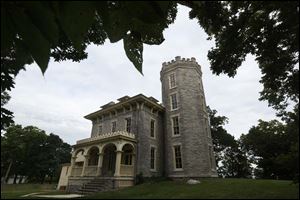
The exterior of Cooke Castle on Gibraltar Island.
GIBRALTAR ISLAND, Ohio — Jay Cooke, the prominent Philadelphia banker who developed the plan that financed the Union Army in the Civil War, was also a dedicated fisherman.
When the native of Sandusky decided to build a vacation residence for him and his family, Mr. Cooke chose a site very near his hometown, and a place where he was surrounded by the great fishing of Lake Erie.
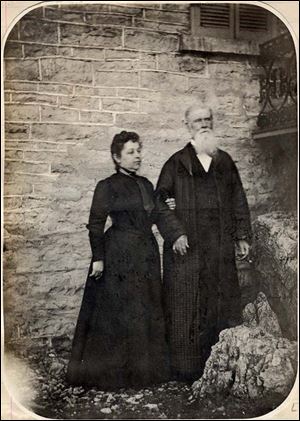
Jay Cooke and his daughter in 1901.
In 1864 Mr. Cooke, whose war bonds program raised more than $1 billion for the U.S. government during the war, purchased this 6.5-acre island that sits in the bay very near South Bass Island.
RELATED ARTICLE: Who was Jay Cooke?
PHOTO GALLERY: Cooke Castle
Mr. Cooke paid $3,001 for Gibraltar, and near the prominent, rocky eastern tip of the island he had his brother Pitt, who still lived in Sandusky, supervise the construction of a 15-room stone mansion that would come to be known to the inhabitants of the surrounding islands as “Cooke Castle.”
For most of the next six decades, Mr. Cooke and his extended family spent time in this unique vacation home at least twice each summer.
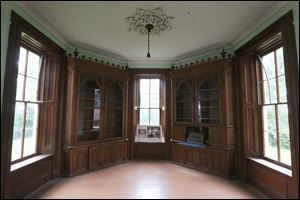
The first-floor library, in the base of the tower, has a 180-degree view of the lake.
He also used the mansion to entertain prominent members of the political and business worlds, including President Rutherford B. Hayes, Gen. William T. Sherman, Salmon P. Chase, Sen. John Sherman, and William Howard Taft, and many of them came here to fish with Mr. Cooke.
“He certainly was a fascinating man,” said Dan Savage, the director of the Lake Erie Islands Historical Society and Museum.
“Cooke fished every opportunity that he could, and he would send fish over to South Bass Island to feed the people.
Here he was, the wealthiest man in the country at this point, and he chose to build that summer home right here. It’s clear that he loved spending time there.”
Mr. Cooke’s extensive journals detailed his numerous fishing and hunting trips on and around the islands, his impressive guest list, family picnics and croquet games on Gibraltar, his faith, and his deep love of his island home.
Mr. Cooke’s mansion, which is now a National Historic Landmark on the National Register of Historic Places, had a four-story Gothic tower with a crenellated observation deck, a library with ornate woodwork and a 180-degree view of the bay and the lake, finely crafted moldings, detailed ceilings, and an overall stately Victorian opulence.
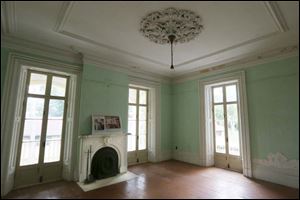
A fireplace, crown molding, floor to ceiling opening doorways and an ornate ceiling light base all serve to embellish the front parlor inside the now defunct Cooke Castle.
Mr. Cooke, a very religious man who declined to see guests on Sundays, also gave members of the clergy use of the mansion as a retreat.
Before he died in 1905, Mr. Cooke wrote a touching farewell to his Lake Erie home, which he called “dear old Gibraltar.”
“We thank God for permitting us to enjoy such a glorious visit,” Mr. Cooke wrote.
Following his death, the island and the castle remained with the family until 1925, when it was sold to Julius Stone, who was on the board of trustees of Ohio State University. Mr. Stone donated the island and its structures to the university to be used for a marine biology laboratory, so OSU also took ownership of the castle.
Maintaining the mansion was a constant challenge for the university, because of the remote location, its fine décor, and the fact Gibraltar Island had become a scientific research facility, occupied seasonally by students and OSU faculty members, but shuttered for about five months each winter.
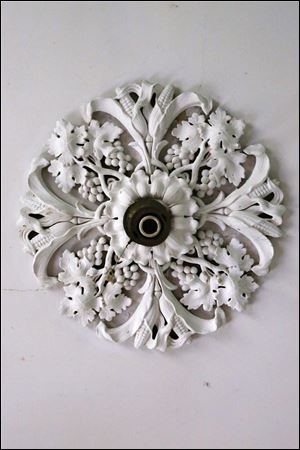
Though the lights are gone, ornate ceiling light bases remain inside Cooke Castle.
For a period of time, Cooke Castle was used as the men’s dormitory on the island, because there were initially many more male students to house than females. Jeff Reutter, the director of Stone Lab on the island, the oldest freshwater biological field station in the country, first came here as a graduate student about 45 years ago, and lived in the men’s housing in the castle.
“It sounds funny now, but we stayed in a castle,” Mr. Reutter said recently. “My dorm room was on the third floor.”
As the years and the fluctuations of the seasons took a toll on the structure, the focus was on maintaining the shell to protect the interior. The roof was kept sound, the decking on the porches replaced with a more durable material, and the mortar repaired.
The interior, however, looks much like it did when Mr. Cooke’s family left the island for a final time.
“The beauty of the original detail is still there,” Mr. Reutter said. “People that see the house always comment on the woodwork. We just need to see if we can bring this place back to life.”
Stone Lab is hoping to raise close to $4 million to completely restore and renovate the historic structure, and bring the electrical and plumbing service up to date. The plan calls for Cooke Castle to be converted into a 13-suite conference and meeting facility where the lab can host its guests, all while preserving the integrity of Mr. Cooke’s island home.
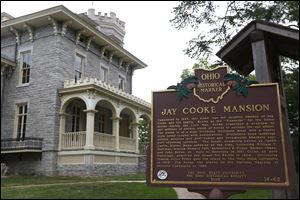
The Jay Cooke Mansion on Gibraltar Island near Put-in-Bay is commonly known as Cooke Castle. Now part of Ohio State University's Stone Lab extension campus, the 15-room castle was built in 1864. To see more photos, go to toledoblade.com.
Currently, any of the researchers, politicians, teachers, reporters, and other representatives of special interest groups that visit the island overnight must be housed in the small student dormitory, which is usually full of students.
Mr. Reutter said hosting outside groups and letting them see firsthand the critical work that goes on at Stone Lab, on the opposite end of the tiny island from the castle, is vital to the research, education, and outreach mission of the facility. Cutting-edge work on the lake’s troubling algae blooms had been done at Stone Lab, as well as research on other issues concerning the Great Lakes.
“Renovating Cooke Castle would give us a unique lodging option, while at the same time preserving and protecting one of the most important historical structures on the islands,” he said. “I think our research programs would greatly benefit from the additional outreach opportunities and we could do a better job protecting Lake Erie and enhancing science education.”
Mr. Savage said the historical significance of Mr. Cooke, plus his lifelong connections to the area, makes restoring the castle a high priority.
“I think it’s very important that this be done, because this man and his home — it’s not just a local thing. He is a very important part of the history of this region, the islands, and the country,” Mr. Savage said. “His bank floated the loans that kept the Union Army going, so think of the impact he has had on American history. Anyone with an interest in history would want to see his home here preserved.”
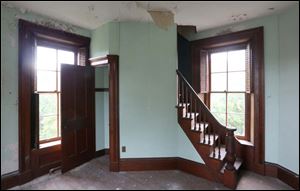
The third floor turret room features a staircase that leads up to another room and finally the roof.
Mr. Reutter said that Stone Lab is trying to raise the funds for restoration through donations of any size, from any source.
“We hope that by getting the word out about this wonderful structure and its rich history, and about what great research work goes on here on the island today, we can get the support of anyone who has a love of Lake Erie, the islands, history, science, or grand old buildings with such a story to tell.”
Mr. Reutter lamented the fact that on each summer weekend, when the adjacent Put-in-Bay harbor is jammed with pleasure boats, yachts, and large sailboats, there is likely an individual close by who has the financial capability to put the renovation into motion.
“We just need to make sure we are reaching as many people as possible so they know what is out here, and why what we are trying to do is so important,” he said.
More information on the Cooke Castle renovation project and the Ohio State Stone Lab research facility is at stonelab.osu.edu, or by calling 614-292-8949.
Contact Blade outdoors editor Matt Markey at: mmarkey@theblade.com or 419-724-6068.